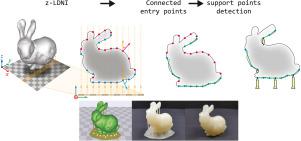Computer-Aided Design ( IF 3.0 ) Pub Date : 2020-06-25 , DOI: 10.1016/j.cad.2020.102908 Seongje Jang , Byungjin Moon , Kunwoo Lee

|
To print a 3D model with a 3D SLA printer, support structures are required for areas such as overhangs and islands. If there is no support structure below islands, the solidified material will float around in the vat. Further deposition in the areas will sink as well, resulting in a printing failure. This issue is called the floating island problem. To resolve this problem, two different approaches to detect support points have been developed. One is a slice-based approach that pre-slices the given 3D model and compares all sets of two consecutive layers; this is computationally inefficient. The other is a mesh-based approach that investigates primitives such as points, edges, and faces and samples the clusters; this method, however, tends to miss the local minimums and causes the problem.
In this paper, we propose a novel method to create support structures. This method does not lead to the floating island problem, in contrast to the mesh-based approach. Besides, this method does not need pre-slice 3D models, nor does it need to compare slices. It first converts a 3D model into a geometric representation called a layered depth image (LDI). It then creates a directed graph from the LDI to describe the delivery path of self-support and identifies efficient support points to prevent material waste. The structures can be reinforced by considering the volume as well as the geometry of the model. They are also reinforced by adding connections between anchors to increase stability. This method is compared to well-known commercial slicers. The result proves that this method is computationally efficient and never causes floating island problems.
中文翻译:

自由浮动的支持结构生成
要使用3D SLA打印机打印3D模型,悬垂和孤岛等区域需要支撑结构。如果在岛下方没有支撑结构,则固化的材料将在槽中漂浮。该区域中的进一步沉积也会下沉,从而导致打印失败。此问题称为浮岛问题。为了解决这个问题,已经开发了两种不同的方法来检测支持点。一种是基于切片的方法,该方法可以对给定的3D模型进行预切片,并比较两个连续图层的所有集合。这在计算上效率低下。另一种是基于网格的方法,该方法研究诸如点,边和面之类的图元并对样本进行采样。但是,这种方法往往会漏掉局部最小值并引起问题。
在本文中,我们提出了一种创建支撑结构的新方法。与基于网格的方法相比,此方法不会导致浮岛问题。此外,该方法不需要切片前3D模型,也不需要比较切片。它首先将3D模型转换为称为分层深度图像(LDI)的几何表示。然后,它从LDI创建一个有向图,以描述自我支撑的传递路径,并确定有效的支撑点以防止材料浪费。可以通过考虑模型的体积和几何形状来加强结构。通过在锚之间增加连接以增强稳定性,它们也得到了加强。将该方法与公知的商业切片机相比较。











































 京公网安备 11010802027423号
京公网安备 11010802027423号